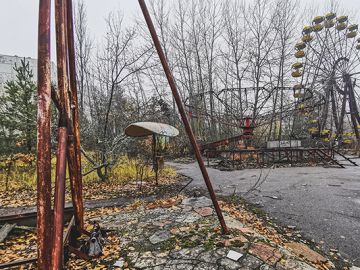Surreal. Eerie. Haunting.
Three words that can be used to describe a visit to Chernobyl’s Exclusion Zone.
On our first ever Chernobyl and Kiev Long Weekend exploration trip, Exodus Social Media Marketing Manager, Milly Youngman, takes one step towards the surreal in the Exclusion Zone to experience the history and lingering effects of one of the world’s most devastating nuclear disasters…
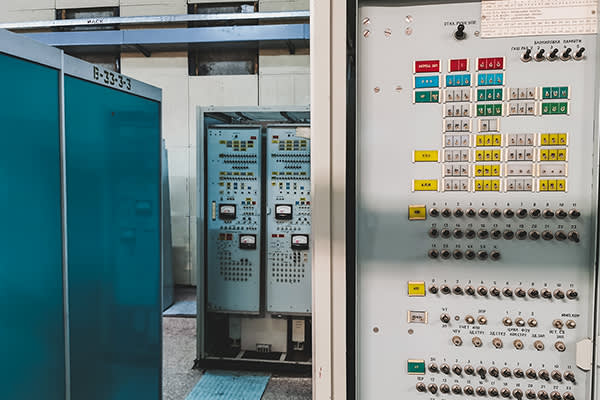
The Chernobyl Nuclear Power Plant
Most visitors to Chernobyl will only catch sight of the power plant from the outside, gazing up at the ‘sarcophagus’ that encases ground zero of the explosion, Reactor 4. Tours of the power plant itself are usually restricted to study visits, but on the Exodus Chernobyl and Kiev Long Weekend, we’re able to walk in the footsteps of the engineers working at the plant on the very day of the disaster.
Meeting our power plant guide, we’re escorted down to the shelter – a series of basement rooms with bunk beds, safety information and the communications chamber. It was from here that news of the disaster spread, with the emergency protocol decided and enacted.
The next step in our journey requires a slight outfit change, with the group donning protective coats, footwear, hats, gloves and masks. This caused a little concern, but we’re reassured that the get-up is intended to protect us from dust rather than radiation.
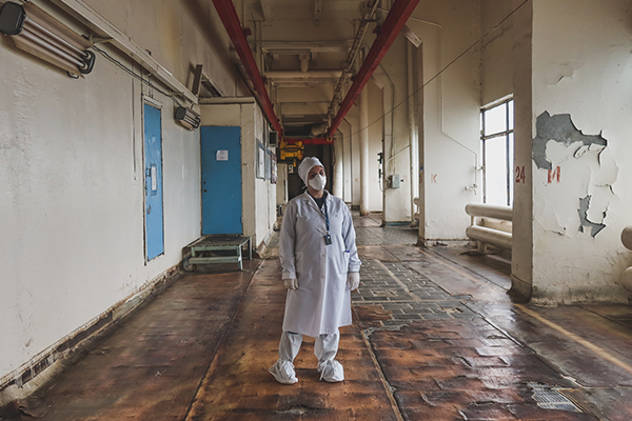
Making our way along corridors that date back to the 1970s, we take in equipment rooms, views over the plant and the control room for Reactor 3. After the accident, the power plant’s other reactors continued to operate, but the whole site was decommissioned in 2000. Current employees working on the decommission process occasionally cross our path, walking with purpose and barely acknowledging our visit.

The Duga Radar
Operational in the 70s and 80s, the Duga Radar served as an early warning system to detect enemy missiles. Today, it stands dormant and mysterious, towering over the forest and dilapidated buildings below. The tallest section is 150 metres high, dwarfing the still-impressive 80 metre antenna beside it.
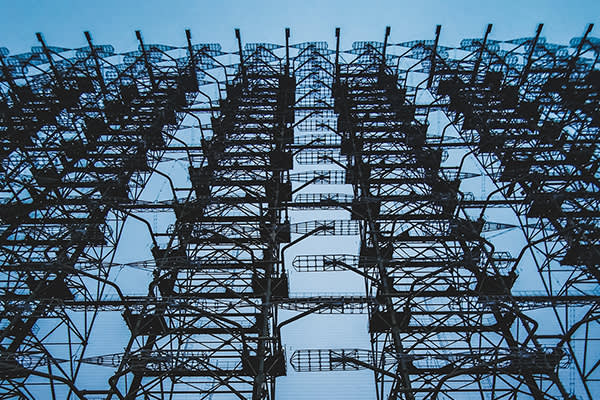
As the daylight quickly fades, we take a walk underneath the imposing structure, surrounded by woodland. Wild dogs bark in the distance, and we make our way back to the bus and onto our night’s accommodation in Chernobyl town, keen to dissect the day’s exploration.
The buried village of Kopachi
Only two buildings remain in Kopachi, a village struck by radiation and buried underneath the soil. One of those buildings is our first destination for day two and a first exploration into an evacuated space, Kopachi’s kindergarten.
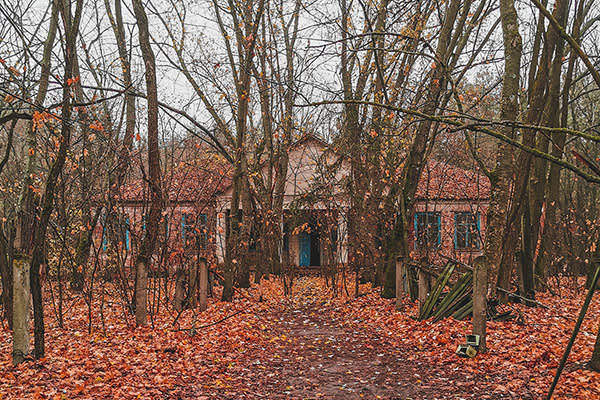
Instantly, the immediacy and urgency of the evacuation hits. Books are strewn haphazardly, toys abandoned, and lockers hang open (although we’re later informed that the placement is often altered by photographers, rather than an untouched capsule of the final moments of activity in the building). Cracks line the walls, and we tiptoe around a hole of broken floorboards in one of the nursery rooms.

The children’s bunk beds remain in one of the dilapidated rooms here. Momentarily alone, it’s easy to be transported to 1986, just seconds before the disaster strikes. In those moments, the rooms overflow with boisterous young lives that would forever be changed in the hours, days and months to follow.
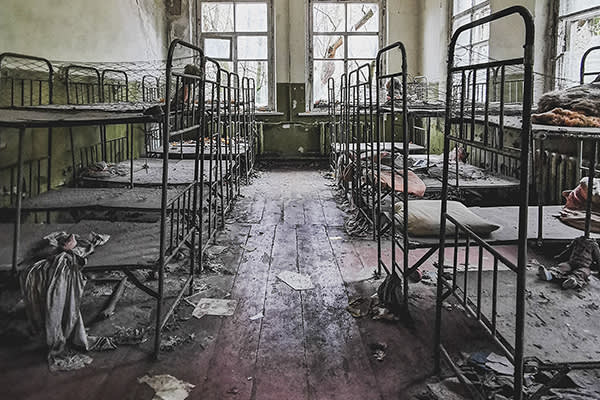
The abandoned city of Pripyat
When the Chernobyl Power Plant was opened in 1977, the nearby community of Pripyat became home to its employees and their families – growing rapidly enough to be granted city status in 1979.
Having seen countless Instagram images of Pripyat before visiting, it’s easy to feel prepared. But quite honestly, all the photographs in the world couldn’t evoke the feelings experienced on a visit to the city.

From the looted shell of a local supermarket to the abandoned stadium, the city has been left to fall into disrepair. As our guide Tanya tells us, “no one cares about this place”. Uninhabitable and patrolled by security, no one has lived in Pripyat since the evacuation. But it hasn’t stopped street art from appearing, often overnight, from commissioned artists and unauthorised visitors alike.
One of perhaps the most iconic spots, the Pripyat Amusement Park, operational for just one day before evacuation, proves to be a highlight for many on the tour. But it’s a walk among the district buildings where people made their homes that truly encapsulates the scale and emptiness of the city. Open doors and rubble hide beyond overgrown wilderness, in a place where nature has truly overtaken a place that many once called home.
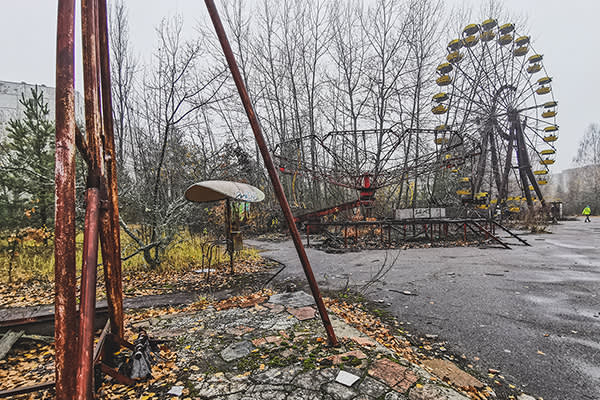
The self-settlers of Chernobyl
After the disaster in 1986 and subsequent evacuation, families were given apartments in nearby towns and cities. But some refused to give up the homes they’d lived in their whole lives, and a group known as ‘self-settlers’ returned to their lives within the outer limits of the exclusion zone.
On our second day of visiting Chernobyl, we visit the home of one such self-settler, an 80-year-old woman named Valentina.
The group crowd into her small dining room, perched on a window ledge and on a sofa, as her miniature dog yaps and dances at the sight of visitors. She tells us her story, how she came back within months of evacuation to return to her home and family life. Valentina has a daughter, and a son who works at the Chernobyl power plant – staying with her when he works his shift patterns. She has friends living nearby, and plays the accordion, which she demonstrates to us before pouring extremely generous glasses of neat vodka as a gesture of hospitality in Ukraine.
Valentina gives us a fascinating insight into the people behind the disaster, so much more than just a dramatised piece on television or a Wikipedia article could ever invoke. Her story is individual, but also representative of a 200-strong community, many of which are in the later years of life.
Before returning to Kyiv, two hours away, we take our final look at this captivating, moving place, and consider the impact one day had not just on this 30km space of land, but far beyond.
The Chernobyl and Kiev Long Weekend is a three-night tour that includes two days exploration of the Chernobyl Exclusion Zone.
